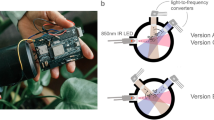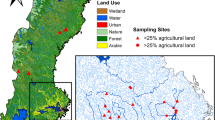Abstract
Purpose
Optical turbidity sensors have been successfully used to determine suspended sediment flux in rivers, assuming the relation between the turbidity signal and suspended sediment concentration (SSC) has been appropriately calibrated. Sediment size, shape and colour affect turbidity and are important to incorporate into the calibration process.
Materials and methods
This study evaluates the effect of SSC and particle size (i.e. medium sand, fine sand, very fine sand, and fines (silt + clay)) on the sensitivity of the turbidity signal. Three different turbidity sensors were used, with photo detectors positioned at 90 and 180 degrees relative to the axis of incident light. Five different sediment ratios of sand:fines (0:100, 25:75, 50:50, 75:25 and 100:0) were also evaluated for a single SSC (1000 mg l-1).
Results and discussion
The photo detectors positioned at 90 degrees were more sensitive than sensor positioned at 180 degrees in reading a wide variety of grain size particles. On average for the three turbidity sensors, the sensitivity for fines were 170, 40, and 4 times greater than sensitivities for medium sand, fine sand, and very fine sand, respectively. For an SSC of 1000 mg l-1 with the treatments composed of different proportions of sand and fines, the presence of sand in the mixture linearly reduced the turbidity signal.
Conclusions
The results indicate that calibration of the turbidity signal should be carried out in situ and that the attenuation of the turbidity signal due to sand can be corrected, as long as the proportion of sand in the SSC can be estimated.





Similar content being viewed by others
References
ASTM International (2003) D1889-00 Standard test method for turbidity of water. In: ASTM International, Annual Book of ASTM standards, Water and Environmental Technology, V. 11.01, West Conshohocken, Pennsylvania, USA
Bortoluzzi EC, Poleto C (2006) Sediment studies methods. In: Poleto C, Merten GH (eds) Sediment Quality. ABRH Publication, Porto Alegre, Brazil, pp 83–144 (in Portuguese)
Bunt JAC, Larcombe P, Jago CF (1999) Quantifying the response of optical backscatter devices and transmissometers to variations in suspended particulate matter. Cont Shelf Res 19:1199–1220
Butt T, Miles J, Gauderton P, Russel P (2002) A simple method for calibration optical backscatter sensor in high concentrations of non-cohesive sediments. Mar Geol 192:419–424
Conner CS, De Visser AM (1992) A laboratory investigation of particle size effects on an optical backscatterance sensor. Mar Geol 108:151–159
Downing J (2006) Twenty-five years with OBS sensors: The good, the bad, and the ugly. Cont Shelf Res 26:2299–2318
Downing J, Beach RA (1989) Laboratory apparatus for calibration optical suspended solids sensors. Mar Geol 86:243–249
Foster IDL, Millington R, Grew RG (1992) The impact of particle size controls on stream turbidity measurement; some implications for suspended sediment yield estimation. In: Bogen J, Walling DE, Day TJ (eds) Erosion and sediment transport monitoring programs in river basins. IAHS Publ 210, IAHS Press, Wallingford, UK, pp 51–62
Gippel CJ (1995) Potential of turbidity monitoring for measuring the transport of suspended solids in streams. Hydrol Process 9:83–97
Hatcher A, Hill P, Grant J, Macpherson P (2000) Spectral optical backscatter of sand suspension: effects of particle size, composition and color. Mar Geol 168:115–128
Horowitz AJ (1991) A primer on sediment trace element chemistry, 2nd edn. Lewis Publishers, Chelsea, USA
Lewis J (2002) Estimation of suspended sediment flux in streams using continuous turbidity and flow data coupled with laboratory concentrations. In: Proceedings of the Federal Interagency Workshop on Turbidity and Other Sediment Surrogates, Appendix 2, U.S. Geological Survey. Circular 1258. Reno, Nevada, USA
Ludwing KA, Hanes D (1990) A laboratory evaluation of optical backscatterance suspended solids sensors exposed to sand-mud mixtures. Mar Geol 94:173–179
Minella JPG, Walling DE, Merten GH (2008) Combining sediment source tracing techniques with traditional monitoring to assess the impact of improved land management on catchment sediment yields. J Hydrol 348:546–563
Morris GL, Annandale G, Hotchkiss R (2008) Reservoir sedimentation. In: Garcia M (ed) Sedimentation engineering process measurements, modeling and practices. Amer Soc Civil Engineer (ASCE), Reston, USA, pp 1–17
Nolan KM, Gray JR, Glysson GD (2005) Introduction to suspended-sediment sampling. U.S. Geological Survey Scientific Investigations Report 2005–5077, 1 CD-ROM, available on Web, accessed January 27, 2013, at http://pubs.usgs.gov/sir/2005/5077/
Rasmussen PP, Gray JR, Glysson GD, Ziegler AC (2009) Guidelines and procedures for computing times-series suspended-sediment concentration and loads from in-stream turbidity-sensor and streamflow data. U.S. Geological Survey Techniques and Methods Book 3, Chapter 4, 53 p., available on Web, accessed January 27, 2013, at http://pubs.usgs.gov/tm/tm3c4/
Sadar MJ (1998) Turbidity science –Technical Information Series-Booklet No.11, 26 p. Available on Web, accessed July 2012, at http://www.hach.com/fmmimghach?CODE%3AL7061549%7C1
Schoellhamer DH, Wright SA (2002) Continuous measurement of suspended-sediment discharge in rivers by use of optical backscatterance sensors. In: Bogen J, Fergus T, Walling DE (eds) Erosion and sediment transport measurement in rivers. IAHS Publ 283, IAHS Press, Wallingford, UK, pp 28–36
Van de Hulst HC (1981) Light scattering by small particles. Dover Publications, New York, USA
Vanoni, VA (ed) (1975) Nature of sedimentation problems in sedimentation engineering, ASCE Task564 Committee for the Preparation of the Manual on Sedimentation of the Sedimentation Committee of the Hydraulics 565 Division, New York, USA, pp 1–16
WMO (2003) Manual on sediment management and measurement. World Meteorological Organization, Geneva, Switzerland
Acknowledgements
The authors would like to thank Casey J. Lee of the USGS Kansas Water Science Center, Lawrence, KS, and Christopher A. Ellison and Jason L. Roth of the USGS Minnesota Water Science Center, Mounds View, MN, on the valuable contribution to improving this article. The authors would also to thank Jorge Rosso of Solar SA, Florianópolis, Brazil, for the generous loan of the optical turbidity sensors used in this study and Kimberlie Perkins, USGS, National Research Program, Menlo Park, CA, for the particle size analysis. Financial support was provided by CNPq – Conselho Nacional de Desenvolvimento Científico e Tecnológico Programa Ciência Sem Fronteiras. Any use of trade, product, or firm names is for descriptive purposes only and does not imply endorsement by the U.S. Government.
Author information
Authors and Affiliations
Corresponding author
Additional information
Responsible editor: Jorge Enoch Furquim Werneck Lima
Rights and permissions
About this article
Cite this article
Merten, G.H., Capel, P.D. & Minella, J.P.G. Effects of suspended sediment concentration and grain size on three optical turbidity sensors. J Soils Sediments 14, 1235–1241 (2014). https://doi.org/10.1007/s11368-013-0813-0
Received:
Accepted:
Published:
Issue Date:
DOI: https://doi.org/10.1007/s11368-013-0813-0




